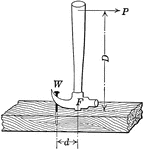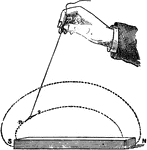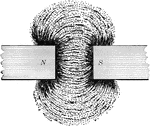
Battering Ram
"Batering-ram, an engine for battering down the walls of besieged places. The ancients employed two…
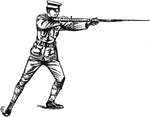
Bayonet Thrust
"The force of the thrust is delivered principally with the right arm, the left being used to direct…
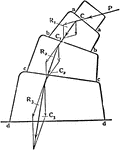
Buttress of Blocks
Uniting the theories of partial polygons of resistance and centres and lines of resistance, this buttress…
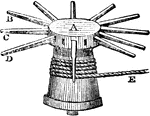
Capstan
"The capstan, in universal use, on board of ships, is an axle placed upright, with a head, or drum,…
Cathode
This illustration shows rays attracted to a magnet, and exerting force upon the object against which…
Centrifugal Force
"When a vessel containing water is whirled rapidly round, why does not the water fall out when the vessel…
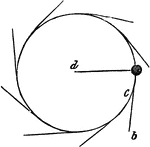
Centrifugal Force
"Suppose a cannon ball, tied with a string to the centre of a slab of smooth marble, and suppose an…
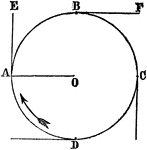
Centrifugal Force
"Attach a ball, for instance, to a cord; and , fastening the end of the cord at a point, O, give a quick…

Centrifugal Force
"The instant one of the strings is let go, the centrifugal force carries off the stone in a tangent…
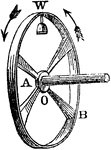
Centrifugal Force Demonstration
"AB is a wheel with a broad rim, or felly. A wine glass partly filled with water is placed on the inner…

Connected dynamo and motor
"Where a motor is connected with the electric circuit of a dynamo...and the armature of the dynamo is…
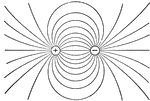
Electricity
This illustration shows the field between two equally and oppositely charged spheres, mapped out by…
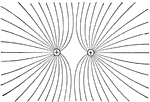
Electricity
This illustration represents the field between two equal positive charges; in this case the lines of…

Electricity
This illustration shows the lines of force when a positive charge equal to 4 at A, and a negative charge…
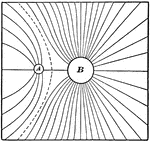
Electricity
This illustration shows the field of force due to a charge 1 at A, and a like charge 4 at B.

Electricity
This illustration shows the field of force between two parallel planes. At the edges its lines of foce…

Electricity
A is a positively charged conductor and B represents the equal and oppsite charge. When the conductor…
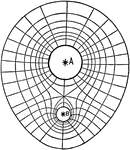
Equipotential Lines
"When a charge is moved from any point to another point in the same equipotential surface, no work is…
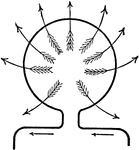
Magnetic Field Around a Current Carrying Wire
"If the conducting wire is bent into the form shown, the lines of force will pas around the wire from…

Inclined Plane with the Force Acting Parallel to the Base
"An inclined plane is a slope, or flat surface, making an angle with a horizontal line...the force acts…

Inclined Plane with the Force Acting Parallel to the Plane
"An inclined plane is a slope, or flat surface, making an angle with a horizontal line...the force acts…

Force pump
"The operation of the force-pump is similar to that of the suction-pump. The outlet-valve generally…

Steam-engine Force Pump
"The force-pump differs from others in having its piston solid, or without a valve, and also in having…
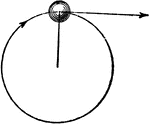
Centrifugal Force
"If a body be fastened to a string and whirled, so as to give it a circular motion, there will be a…

Forcing-Pump
"In the forcing-pump atmospheric pressure plays but a small part. There is no valve in the piston c,…
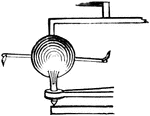
Hero's Machine
"Hero's Machine. The generation of steam from water by the application of heat, and the mechanical force…

Hydraulic Bellows
"An instrument called the hydrostatic bellows, also shows, in a striking manner, the great force of…

Inlined Plane with Weight
"The power required to force a given weight up an inclined plane, is in proportion to its height, and…

Lines of Force under Induction
"Lines of force of a charged sphere and a conductor under induction. The negative electrification on…

Lever
"The object W to be lifted is called the weight; the force is represented by P; the point, or pivot,…

Lever
"The object W to be lifted is called the weight; the force is represented by P; the point, or pivot,…
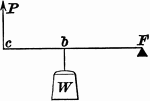
Lever
"The object W to be lifted is called the weight; the force is represented by P; the point, or pivot,…
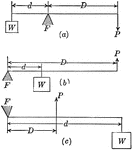
Lever and Fulcrum
Illustration of a lever with fulcrum F. W represents the weight lifted, P is the force that does the…
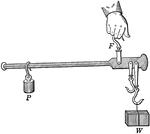
Steel-yard Used as a Lever
Illustration of an ordinary steel-yard being used as a lever. F represents the fulcrum. Weight P is…

Lines of Force
"Lines of force of a circular loop. If a current flow through the loop in the direction indicated, the…

Lines of Force
"Lines of force in a circular loop. If the loop pass through a piece of cardboard at right angles to…
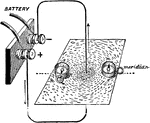
Magnetic Field
"Experiment showing lines of force in the magnetic field surrounding a conductor carrying an electric…

Magnetism
"Experiment illustrating the molecular theory of magnetism. Coarse steel filings are placed inside a…

Maxwell's Corkscrew Rule
"Illustrating Maxwell's 'corkscrew rule' for relative directions of current and lines of force...a current…

Motions Of 2 Points In Same Plane And Parallel
Illustration showing two points a and b to be in the same plane and parallel.

Motions Of 2 Points In Same Plane And Parallel
Illustration showing two points a and b to be in the same plane and parallel.
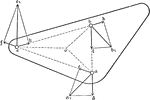
Motions Of 3 Points
Illustration showing three points a, b, and c in motion. The magnitude and direction of a and b are…

Parallelopiped of Motions
Illustration used "If three component motions ab, ac, and ad are combined, their resultant af will be…

Parallelogram
"In the diagram, let AB and AC represent two forces acting upon the point, A. Draw the two dotted lines…
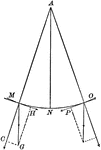
Motion of a Pendulum
"When the pendulum is drawn from its vertical position, the force of gravity, MG, is resolved into two…

Hydraulic Machine Exerting Pressure
Illustration of a hydraulic machine. "A principle known as Pascal's Law states that pressure exerted…
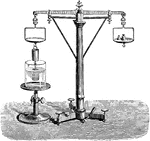
Experimental Verification of Principle of Archimedes
An experimental verification of the Principle of Archimedes.
!["A double-acting pump of the piston pattern is shown [here]. Such a pump has two sets of suction valves and delivery valves, one set for each side of the piston. With the piston moving in the direction of the arrow, the pressure of the atmosphere forces the water up the suction pipe P into the left-hand end of the pump cylinder, the left-hand suction valve opens and the left-hand delivery valve is closed...The water now flows up the delivery pipe P'." —Hallock 1905](https://etc.usf.edu/clipart/36100/36170/2act_fpump_36170_mth.gif)
Double-acting Force Pump
"A double-acting pump of the piston pattern is shown [here]. Such a pump has two sets of suction valves…
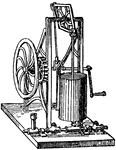
Force Pump
An illustration of a force pump which is used to force liquid up and expel it under pressure.
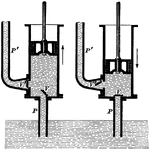
Forcing Pump
"As the piston ascends, as shown in the left-hand figure, the pressure of the atmosphere forces the…

Hand Operated Pump
One sort of pump once common worldwide was a hand-powered water pump over a water well where people…
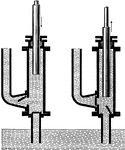
Plunger Pump
"The action does not differ in any way from that of the piston force pump. During the up stroke of the…
!["Steam pumps are force pumps operated by steam acting on the piston of a steam engine directly connected to the pump, and in many cases cast with the pump. A section of a double-acting steam pump, showing the steam and water cylinders, with other details, is illustrated [here]." —Hallock 1905](https://etc.usf.edu/clipart/36100/36172/steam_pump_36172_mth.gif)
Steam Pump
"Steam pumps are force pumps operated by steam acting on the piston of a steam engine directly connected…

Resultant Motion with Boat
"Let, for instance, the force used by the boatman be twice as great as that of the tide. Then by the…

Vector Addition Given Resultant
Illustration "where ad is the given resultant, if the two components have the magnitudes represented…


